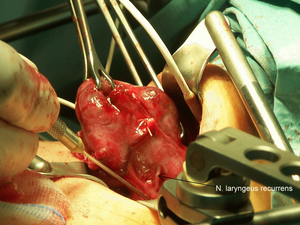Recurrent laryngeal nerve paresis
From WikiLectures
Nervus laryngeus recurrens sensitively innervates the subglottic part of the larynx and motorically all muscles of the larynx except the cricothyroideus muscle.
Paresis of the recurrent laryngeal nerve can occur:
- Damage to the nuclei of the vagus nerve;
- By damage to the vagus nerve above the recurrent laryngeal nerve – tumor, trauma, neurological disease, skull base surgery;
- Damage to recurrent laryngeal nerve – neck surgery, upper mediastinal surgery and especially thyroid surgery.
Unilateral paresis[edit | edit source]
- Unilateral paresis is manifested by a phonation disorder. Inspiratory dyspnea is not present.
- The vocal cord becomes immobile, it is fixed in the paramedian position.
- Therapy: phoniatric care - in case of failure, surgery (thyreoplasty) comes next.
Bilateral paresis[edit | edit source]
- Bilateral paresis leads to airway stenosis in the glottis region.
- It is clinically manifested by dysphonia , dysphagia and inspiratory dyspnea with inspiratory stridor.
- The vocal cords are immobile, fixed in a paramedian position.
- Therapy: provision of airways, widening of the respiratory slit (laterofixation of the vocal cords, arytenoidectomy, chordectomy).
Links[edit | edit source]
Related Articles[edit | edit source]
External links[edit | edit source]
Disorder of innervation of the vocal cords
Source[edit | edit source]
- BENEŠ, Jiří. Studying materials [online]. ©2007. [cit. 2009]. <http://jirben2.chytrak.cz/materialy/orl_jb.doc>.
Použitá literatura[edit | edit source]
- KLOZAR, Jan, et al. Speciální otorinolaryngologie. 1. edition. Prague : Galén, 2005. 224 pp. ISBN 80-7262-346-X.




